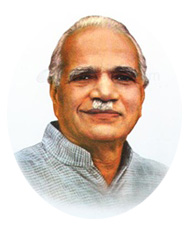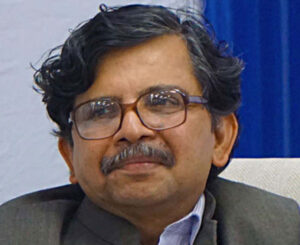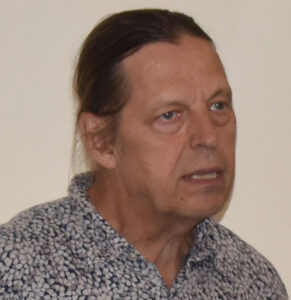
30th J.P.Naik Memorial Lecture
Time to Introspect, Revisit:
50 Years of the Committee on the Status of Women in India
Speaker: Delivered by S.Muralidhar, Former Chief Justice, High Court of Orissa
13th April, 2024, IIC, New Delhi
Video link: https://www.youtube.com/watch?v=8YEc9TQoWiA
:
 S.Muralidhar did his school and college education in Chennai. He completed B.Sc in Chemistry from the Vivekananda College, Chennai in 1981 and BL from the University of Madras in 1984, securing the first rank. He did LL.M from the Nagpur University in 1990, again securing the first rank. Justice Muralidhar was awarded a Ph. D by the University of Delhi in February 2003 for a Doctoral Programme entitled “Legal Aid and the Criminal Justice System in India”.
S.Muralidhar did his school and college education in Chennai. He completed B.Sc in Chemistry from the Vivekananda College, Chennai in 1981 and BL from the University of Madras in 1984, securing the first rank. He did LL.M from the Nagpur University in 1990, again securing the first rank. Justice Muralidhar was awarded a Ph. D by the University of Delhi in February 2003 for a Doctoral Programme entitled “Legal Aid and the Criminal Justice System in India”.
Muralidhar began his law practice in Chennai in September 1984. In July 1987 he shifted his practice to Delhi. He practiced in the Supreme Court of India and the Delhi High Court for nearly two decades. He was an Advocate-on-record in the Supreme Court of India. He conducted several pro bono and PIL cases. He was active as a lawyer for the Supreme Court Legal Services Committee. Apart from being the counsel for the Election Commission of India and the National Human Rights Commission, he was a part-time member of the Law Commission from December 2002 till May 2006.
Muralidhar was appointed as a Judge of High Court of Delhi on 29 May 2006. He became the Chief Justice of the High Court of Orissa on 4th January 2021 and retired on 7th August 2023. As a judge he delivered judgments in every branch of law including constitutional, commercial, arbitration law, tax and criminal laws. Many of the judgments have contributed to the development of law in that field. As Chief Justice of the High Court of Orissa, he spearheaded reforms on the administrative and judicial fronts both in the High Court and the district courts. The notable initiatives included the establishment of state-of-the-art centres for digitisation of records of the courts and the setting up of the Centre for Judicial Archives and the Museum of Justice in Cuttack.
On 17 October 2023 Muralidhar was designated as Senior Advocate by the Supreme Court of India and has since returned to practice.
29th J.P.Naik Memorial Lecture
Will prenatal sex selection ever stop?
Speaker: Christophe Z Guilmoto, Senior Fellow in Demography, Centre des Sciences Humaines, New Delhi
Date: 3rd February, 2023
Video link: https://youtu.be/aoksoTBpVNs
:
 Prenatal sex selection proved initially difficult to identify after high proportions of male births were first noticed in some Asian countries in the 1980s. It first took years for statisticians to agree on the magnitude of sex imbalances at birth and the role played by sex-selective abortions in them, and even more years for governments to acknowledge the presence of deliberate elimination of female births. The interpretation of a phenomenon observed in India–but also from Albania to South Korea–was no easier in view of the cultural, economic and political diversity of affected countries and the multiplicity of potential local factors, ranging from family planning policies and dowry to political crises or conflicts. While son preference (or daughter aversion) is at the core of prenatal sex selection, we need to recognize the contributions of other factors such as smaller family size (the so-called fertility squeeze effect) and the emergence of prenatal sex diagnosis tools such as ultrasound.
Prenatal sex selection proved initially difficult to identify after high proportions of male births were first noticed in some Asian countries in the 1980s. It first took years for statisticians to agree on the magnitude of sex imbalances at birth and the role played by sex-selective abortions in them, and even more years for governments to acknowledge the presence of deliberate elimination of female births. The interpretation of a phenomenon observed in India–but also from Albania to South Korea–was no easier in view of the cultural, economic and political diversity of affected countries and the multiplicity of potential local factors, ranging from family planning policies and dowry to political crises or conflicts. While son preference (or daughter aversion) is at the core of prenatal sex selection, we need to recognize the contributions of other factors such as smaller family size (the so-called fertility squeeze effect) and the emergence of prenatal sex diagnosis tools such as ultrasound.
But can the retrospective understanding of the emergence of prenatal sex selection help us to foresee its future evolution? It is time to wonder if after decades of sex imbalances at birth in several countries from Eastern Europe to Eastern Asia, we are in a better position to anticipate the future course of sex selection. As is common with demographic matters, government interventions are expected to correct population issues and the gradual introduction of policies targeting sex selection—starting with India’s Pre-Conception & Pre-Natal Diagnostic Techniques Act rolled out as early as 1994—was supposed to reduce the propensity of couples to resort to sex selection. But in view of the modest effectiveness of these policies, the prognosis for future reductions in sex imbalances at birth may appear less optimistic. After all, fertility in many affected countries has become or remained very low—often below the replacement level—and should continue to exert pressure on parents who want a son. Similarly, access to sex-selective technologies has gradually improved due to the expansion of the private healthcare system. Finally, there is no forceful theory for a downturn in son preference as women’s condition was on the whole already improving decades ago.
This presentation will look at the various trajectories of the sex ratio at birth across the world to try and decipher its specific patterns. We show that somewhat independently of the pace of local socioeconomic change or of government interventions, sex imbalances appear to invariably level off at a high plateau level—corresponding to a deficit of female births of 5-15%—and to start declining subsequently. This regular patterning can be even replicated statistically by using Bayesian tools and the latest forecasts point to a future downturn of prenatal sex selection and its probable disappearance within the next two decades.
We will argue that factors endogenous to the initial rise of sex-selective abortions may account for its ultimate downturn and a return to normalcy. While offering a somewhat optimistic assessment of the apparently spontaneous evolution of sex imbalances, this interpretation should not minimize their lasting impact of the age and sex structures of affected populations or underemphasize the massive marriage squeeze mounting in countries such as China or India.
- 28th J.P.Naik Memorial Lecture “Social Protection at the Crossroads:Towards a better Future?” by Prof. Shahra Razavi, Director, Social Protection Department, ILO on 20 December 2021
- 27th J.P.Naik Memorial Lecture on Global Reproductive Markets and Reproductive Justice: Borders, Nationalisms and Migration by Michal Nahman, 17th January, 2020
- 26th J.P.Naik Memorial Lecture on “Beyond “Lean In”: Toward a Feminism for the 99%” by Nancy Fraser, Loeb Professor, Departments of Philosophy and Politics, New School for Social Research, New York on 22nd March, 2018
- 25th J.P.Naik Memorial Lecture on ‘Equal If Not Superior’: American Missionaries among the Nagas by Geraldine Forbes on 1st March, 2017
- 24th J.P.Naik Memorial Lecture on Education and Girlhood by Prof. Krishna Kumar on 22 April, 2016
- 23rd J.P.Naik Memorial Lecture on Doing Gender, Doing Development: Interrogating Indian State’s attempts at ‘Doing Development’ through Gender by Padmini Swaminathan on 13th August, 2014
- 22nd J.P.Naik Memorial Lecture on Women’s Studies in Academia and Development Discourse by Prof. Maithreyi Krishnaraj on 27 September, 2012
- 21st J.P.Naik Memorial Lecture on Prison Abolition and the Challenges of Feminism by Angela Y. Davis, 4th September, 2011
2001 to 2010
- 20th J.P.Naik Memorial Lecture on Governmentality, Democracy and Capitalist Development: From the Politics of Transition to the Politics of Exclusion by Prof. Kalyan Sanyal on 12th November, 2009
- 19th J.P.Naik Memorial Lecture on Do Women Need Education? Colonial and Contemporary Discourses by Prof. Sabyasachi Bhattacharya, 2008
- 18th J.P.Naik Memorial Lecture on Marriage, Motherhood and Masculinity in the Global Economy: the emerging crisis in social reproduction by Prof. Naila Kabeer, 2007 on 6th February, 2007
- 17th J.P.Naik Memorial Lecture on Selecting Identities from the Past, Prof. Romila Thapar, 2005
- 15th J.P.Naik Memorial Lecture on Memory and Rightlessness by Upendra Baxi on 13 December, 2002
- 14th J.P.Naik Memorial Lecture on Alternative Interpretations of the Ramayana: Views from Below, Nabaneeta Dev Sen, 2001
1982 to 2000
- 11th Towards a Critical Mass: Women in Politics: Hon. Monique Begin, 1998
- 10th J.P.Naik Memorial Lecture on Promises to Keep: Trends in Women’s Studies Worldwide by Dr. Florence Howe, 1995
- 9th J.P.Naik Memorial Lecture on Kinship and Gender in South and Southeast Asia: Patterns and contrasts by Prof. Leela Dube, 1994
- 7th J.P.Naik Memorial Lecture on The Role of Women in a New Health Order by C. Gopalan, CWDS, 1990
- 6th J.P.Naik Memorial Lecture on From a Mans World to a Human World by Justice O. Chinnappa Reddy, CWDS, 1990
- 5th J.P.Naik Memorial Lecture on Education for Women’s Equality by M.S. Gore on 18th February, 1988
- 4th J.P.Naik Memorial Lecture on Women’s Development and Non-aligned Movement by Vida Tomsic, CWDS, 1988
- 3rd J.P.Naik Memorial Lecture on International Women’s Decade: A Balance Sheet by Lucille Mathurin Mair, CWDS, 1984
- 2nd J.P.Naik Memorial Lecture on Some Reflections on Dowry by M.N.Srinivas, CWDS, 1983
- 1st J.P.Naik Memorial Lecture on Role of Education and Research in Enhancing Rural Women’s Income and Household Happiness by M.S. Swaminathan on 11 September, 1982